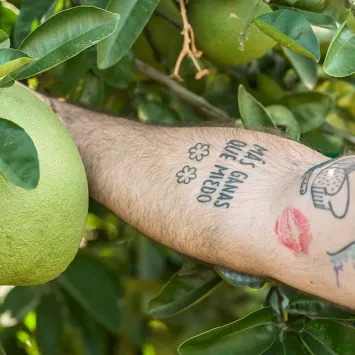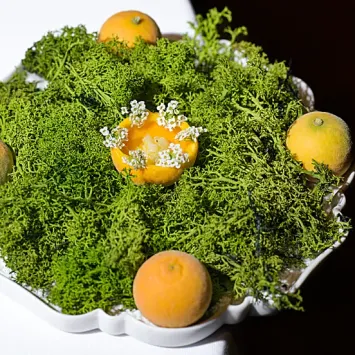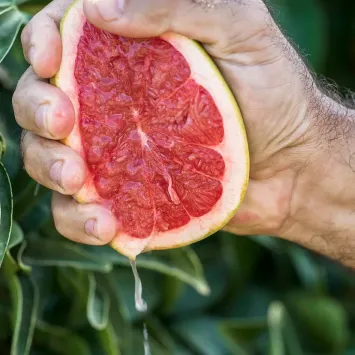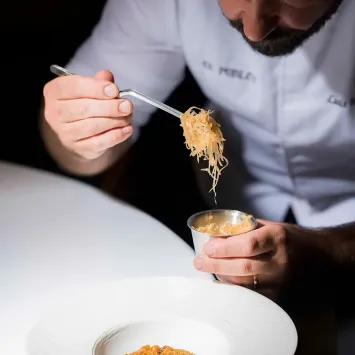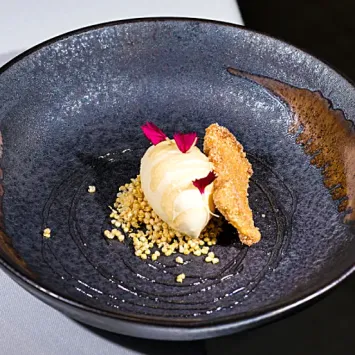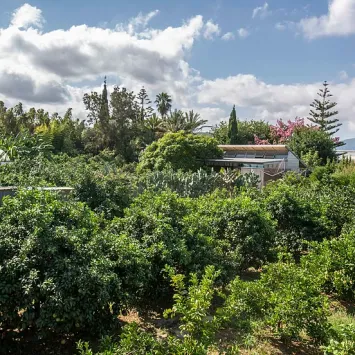Media: Fuera de Serie
Original title: Tiempo de Citrus
Author: Maribel González
Photography: Álvaro Fernández Pietro
Date: 11th October 2025
Citrus Season
It has been a year since the fateful storm Dana and the citrus season is beginning. This is a double reason to return to Valencia and discover the Todolí Foundation with chef Luis Valls, who was born in Picanya and was on the front line during the tragedy. In this orchard, where his mood changes, 500 varieties grow that feed his two Michelin-starred kitchen with a rock & roll soul.
On the morning of 29 October 2024, Luis Valls looked up at the sky and decided to keep his new motorbike in the garage of his house in Picanya, where he was born and has lived for 37 years. He sensed rain, but how could he have imagined the tragedy that Dana would cause a few hours later? He found out while working at El Poblet, a two Michelin-starred restaurant belonging to the Quique Dacosta Group in Valencia. His wife called to tell him that the river had overflowed, that cars were floating, and suddenly the line went dead. He had a ‘shitty night’ and the next morning he showed up in the village with his SUV loaded with food and water, not really aware of what he was going to find: “It was the hardest thing that has ever happened to me. We didn’t suffer any personal losses in the family, but we did in our surroundings, as well as material losses: the motorbike, the car, the materials for the house we were going to start building…”.
At the time, he didn’t think about those things. Nor did he remember to file an insurance claim in the weeks that followed. Because from that morning onwards, he devoted himself to cooking for his neighbours during the day and looking after El Poblet at night. “With the help of local restaurateurs whom I advise, we set up field kitchens in the three most affected towns, because bringing in prepared meals from outside was much more complicated. We made rice dishes in the street, up to 3,000 portions of paella a day, and stews, pasta and salads in the kitchens of the restaurants we were able to clean. In the morning, I would drive to Makro and bring back the food. We managed to get fruit, bread, pastries and even coffee, which was greatly appreciated. It was like this for over a month: ‘At first we were putting out fires, then there was a general lack of coordination in the organisation of the aid. It was hard work, but at least I can take comfort in the fact that people in Picanya ate well,’ he says with a bitter half-smile.
Almost a year after the storm, he remembers it on his way to the Todolí Foundation, his own personal paradise. He is left with the sadness that it could have been avoided and better managed: ‘There is still a lot to be done and the hospitality industry has not fully recovered because, in addition, what had happened was very poorly communicated abroad and this scared away tourists, who thought that the whole city was flooded,’ he says.
Valencia one year after the Dana storm
But life must go on, and his mood changes as soon as he walks through the gates of this orchard in Palmera, about 50 minutes from Valencia, where 500 varieties of citrus fruits grow, which he enjoys using in his kitchen. “This is like a playground for me. Every day I come here, I learn and discover new fruits that I take back to the restaurant to display and experiment with,” he says as he shows off a Valencia lumia, whose albedo (the white layer surrounding the pulp of citrus fruits) he uses to make a unique torrija: ‘We blanch it to remove the bitterness and infuse it with sheep’s milk, which adds sweetness, before frying it and serving it with sourdough ice cream,’ he says, acknowledging that the idea came about after a conversation in which Vicente Todolí, former director of the Tate Modern and founder in 2014 of this 45,000-square-metre orchard, revealed the possibilities of the albedo to him.
As we walk around the main grounds, where some 2,500 citrus trees and shrubs share space with contemporary artworks, such as an aviary for songbirds gifted by artist Carsten Höllen, the chef smells, tastes and photographs varieties as if he were seeing them for the first time: “Look, this is the dragon fly, which you’re going to try because we’re going to take a few with us. It’s interesting because of the velvety texture of its skin and its exotic nuances,” he explains, while in his head he improvises preparing it with cuttlefish and pumpkin as soon as he arrives at the restaurant.
Luis Valls and his cuisine that squeezes the territory
Valls entered the world of Quique Dacosta in 2010 and was working in the kitchens in Dénia when the parent company was awarded its third Michelin star. It was there that the chef from Extremadura discovered his protégé’s potential and entrusted him with a double project in the central Calle Correos 8 in Valencia, Vuelve Carolina, at street level, and El Poblet, on the first floor: ‘At first, we offered Dacosta’s historic classics upstairs, but in the end, we decided to separate the teams, and Quique generously trusted me to let me do my own thing in the kitchen, which is inspired by and based on the pure and simple local area.’
With the help of local suppliers such as Todolí, he draws on ‘ingredients that are very much of the region’ and creates dishes that draw on deep-rooted traditions. “I have a close relationship with them because they reveal things to us that we don’t see even though they are right under our noses. I spend a lot of time with Sergio, who runs our vegetable garden where we do R&D and have even managed to produce tear peas and white strawberries, or talking to fishermen from the Albufera fishing guild, who have introduced me to species such as zander and freshwater hake, or learning from Óscar, from Tot de Poble, a small cheese factory in Castellón that supplies me with all my sheep’s milk because no one cares for their animals like he does, and you can tell by the product.
Adapting to the season marked by the Albufera, the vegetable garden and the sea, Valls constantly updates his menus: Selección (€108, snacks, two main courses, dessert and petit fours), Territori (€165, 9 courses) and Ciutat Vella (€195, 11 courses, of which there is a vegetarian version). Trying the latter is like embarking on a journey through Valencian cuisine, to which Valls adds a touch of rock & roll.
A lover of heavy metal and fan of bands such as Metallica and AC/DC (“I really enjoy going to concerts; the next one will be Bunbury’s, which I’m not so keen on, but it’s my wife’s choice‘), he approaches life and cooking with ’more enthusiasm than fear” (a phrase tattooed on his forearm alongside the two Michelin stars he earned in 2019), and this existential philosophy leads him to challenge diners with every bite. Valls understands that haute cuisine should be enjoyable, but also complex: “To aspire to be a three-star restaurant, you have to take risks and have a critical eye to improve day by day. We have the demands of a three-star restaurant and we try to seek excellence in food, service and liquid harmony so that diners leave happy and enjoy the experience. But I also believe that it’s part of the game to put thought and risk into the dishes so that they take diners by surprise,” he says.
El Poblet’s cuisine, guaranteed fun
In fact, within the first three courses, guests discover that El Poblet is a place to come and play. It starts with intensely flavoured cured meats prepared by the chef and presented in the dining room (note: horse loin, Easter sausage with blue duck, sheep jerky and figatell sobrasada), followed by a gazpachuelo with pine nuts, lacto-fermented green figs and pumpkin seed miso (a dish made from unripe figs that would otherwise be discarded, which Valls turns into the star of the show) and ending with one of the restaurant’s signature dishes, called Tiempo, territorio y temporada (Time, Territory and Season), which is a festival of ingredients, techniques and flavours (beetroot purée, zucchini flower preserved in kombucha vinegar, white prawns from Cullera, puffed Venere rice and Maltese sauce with beetroot kombucha). A trio of dishes that challenge the palate ‘because it has no flavour references to compare them with’ and which demonstrate Valls’ extremely high level of creativity, which is also evident in dishes that speak of tradition, such as fideuá, which pays homage to rossejat noodles and is folded to wrap the meat of the blue crab from La Albufera with a spirulina aioli, or allipebrat-style rice with lacto-fermented lemon.
In between courses, of course, there will be no shortage of red prawns from Dénia, Dacosta’s signature dish, ‘which we serve untouched, simply cooked in seawater because some things cannot be improved upon,’ admits Valls. And finally, another technical display in the form of a Collaret peanut stew with Albufera mallard duck, whose breast is matured in rice and served afterwards: ‘We wanted to make the duck a little more Valencian, so we inoculated it with koji rice and left it to cure for a week and a half to bring out the deeper notes,’ explains the chef, describing a crazy flavour reminiscent of matured steak.
As a farewell, a sensational pre-dessert based on sheep’s milk yoghurt, cucumber and lime ice cream; that albedo French toast born of the chef’s determination to make the most of everything the region has to offer beyond the conventional; and petit fours that, of course, incorporate more varieties of citrus fruits.
To complete the experience of this delightful rollercoaster of flavours that is El Poblet, we highly recommend enjoying the drinks menu designed by Hernán Menno (11 drinks, £127). After almost 10 years working alongside Valls, the duo works perfectly together and there is also a great deal of technique involved in choosing wines that never overshadow the dishes, breaking with classic orders and working from different perspectives, ‘sometimes seeking more affinity of flavours, other times a direct contrast and, in some cases, more discreet profiles than the cuisine’.
Luis Valls and El Poblet, the Dacosta universe with a personal touch
Now that the festival is over, one thing is clear: customers familiar with Quique Dacosta’s cuisine will leave thinking that El Poblet is another world. The style that Valls grew up with can be seen in the aesthetics of the dining room, the excellence of the service and certain dishes, but the cuisine is completely different in this restaurant with its own identity: ‘I’m a little rougher, more extreme, Quique is more refined,’ he says half-jokingly, ‘but he lets me do what I want and knows that I like to take risks.’
After the storm, Valls stopped serving Cañas y Barro for a while, ‘the restaurant’s signature dish in homage to the novel by Blasco Ibáñez’, where Albufera eel is wrapped in chard leaves and cooked in a kind of clay papillote that is broken in the dining room. There were too many mixed feelings in those days when it must not have been easy to juggle the campaign kitchens with those of El Poblet. Fortunately, the dish is back on the menu. Hopefully, the chef will never have to remove it again for the same reason.

